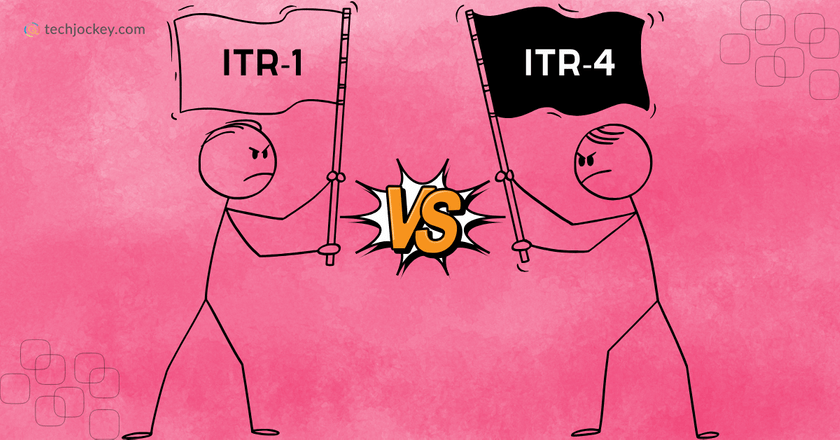Every year, hundreds and thousands of Indian taxpayers lose their heads over the ITR-1 vs ITR-4 debate while filing their taxes. For them, the question is pretty simple: which one of the two income tax return (ITR) forms to choose and why?
For, even though the government of India has made ITR filing relatively easier, choosing the wrong form can lead to rejected filings, penalty notices, or worse, unwanted tax scrutiny.
So, without any further ado, let’s shed a much-needed light on the difference between ITR-1 and ITR-4, so you keep making the right choice for yourself, one assessment year after another…
What are ITR-1 and ITR-4?
Among the various types of income tax return forms, ITR-1 (Sahaj) and ITR-4 (Sugam) top the popularity charts for individuals and small businesses alike.
ITR-1, also known as Sahaj, is designed for salaried Indians, such as working professionals, pensioners, and people with simple incomes. It is called ‘Sahaj’ (meaning ‘easy’) because it covers only straightforward situations, such as…
Suggested Read: What is ITR-1 Tax Form?
- Income from salary or pension
- One house property (without loss carry forward)
- Other sources (like interest income)
- Long-term capital gains (LTCG) under Section 112A up to INR 1.25 lakh
- Agricultural income (up to INR 5,000)
The total income limit? Not more than INR 50 lakh in a financial year. Only resident individuals (not HUFs or companies) can file ITR-1. No complicated business, foreign assets, or multi-house property scenarios here, just the basics.
For instance, for a salaried individual living in Bengaluru with income from salary, interest, and a single flat (no business), ITR-1 fits best.
ITR-4 (Sugam), on the other hand, is the enterprising cousin of ITR-1. It is meant for individuals, Hindu Undivided Families (HUFs), and partnership firms (other than LLPs) who enjoy…
Suggested Read: What is ITR-4 Tax Form That Could Save You Money?
- Income from business or profession under the ‘presumptive taxation scheme’ (Sections 44AD, 44ADA, or 44AE)
- Plus, income from salary/pension, one house property, and other sources (excluding winnings from lottery and racehorses)
- Total income is also capped at INR 50 lakh
- Agricultural income (up to INR 5,000)
The main highlight? Presumptive business income. This scheme lets small business owners and professionals estimate their income as a fixed percentage of gross receipts, saying goodbye to bookkeeping. For anyone who is a freelancer, shop owner, small trader, or a self-employed professional, ITR-4 is usually the preferred path.
For instance, a freelance graphic designer earning INR 20 lakh via client invoices (using Section 44ADA), with a small salary from a part-time job, should file ITR-4.
Key Differences Between ITR-1 and ITR-4
Let’s walk through every essential difference between ITR-1 and 4 to settle the ITR-1 vs ITR-4 debate once and for all…
| Feature | ITR-1 | ITR-4 |
|---|---|---|
| Who can file | Resident individuals only | Individuals, HUFs, Firms (non-LLP) |
| Income limit | ≤ ₹50 lakh | ≤ ₹50 lakh |
| Business income | ❌ Not allowed | ✅ Allowed under presumptive taxation (44AD/44ADA/44AE) |
| House property | Only 1 | Only 1 |
| Agricultural income | ≤ ₹5,000 | ≤ ₹5,000 |
| Foreign income/assets | ❌ Not allowed | ❌ Not allowed |
| Capital gains | ❌ Not allowed | ❌ Not allowed |
| Filing complexity | Very simple | Simple, but needs presumptive scheme details |
1. Income Nature and Source
ITR-1 is tailored for simple income. Salary, pension, interest, and a single house property, it ends there. ITR-4, on the other hand, is designed for the self-employed. It’s used by those earning from business or profession like retailers, consultants, and freelancers under the presumptive tax regime.
2. Presumptive Taxation
ITR-1 doesn’t allow presumptive income. If you run even a tiny business or have professional receipts, this form is not for you. ITR-4, contrarily, is the official home for presumptive income (Sec 44AD: small businesses, 44ADA: professionals like doctors and architects, 44AE: transporters).
3. Who Can File?
Only resident individuals can file ITR-1, no companies, no firms, no HUFs. It also excludes non-residents, directors in companies, and those with foreign assets. ITR-4, conversely, extends to individuals, HUFs, and partnership firms (but not LLPs). Non-residents, those who own foreign assets, and directors are excluded still.
So, ITR-1 bans those with…
- Income from business/profession
- Foreign income/assets
- Capital gains (except LTCG up to INR 1.25 lakh under Section 112A)
- Director status in a company
- Unlisted equity shares
And ITR-4 bans…
- Anyone not eligible for presumptive tax
- LLPs (Limited Liability Partnerships)
- Foreign income or assets
- Multiple house properties
- Those with deferred ESOP tax, unlisted equity during the year, or income under special tax rates
4. Structure & Parts of the Form
ITR-1 is lean. It includes general info, details of income, deductions, taxes paid, and total tax liability. ITR-4, in contrast, is slightly more elaborate to incorporate business/profession details, presumptive income computations, and other financial particulars.
ITR-1 or ITR-4: Choosing the Right Form (In a Nutshell)
Here’s how you can decide between the two…
For ITR-1 (Sahaj):
- You are a resident individual
- Your income is up to INR 50 lakh
- Your earnings are from:
- Salary or pension
- Single house property (no losses carried forward)
- Interest income or other sources (excluding racehorses/lottery)
- Long-term capital gain under Section 112A up to INR 1.25 lakh
- No income from business or profession
- No ownership of foreign assets or directorship in companies
- Agricultural income is equal to or less than INR 5,000
For ITR-4 (Sugam):
- You are a resident individual, HUF, or eligible partnership firm
- Your income is up to INR 50 lakh
- Your primary income is from presumptive business or professional receipts under Section 44AD, 44ADA, or 44AE
- You may also have:
- Income from salary/pension
- Income from one house property (without loss carry forward)
- Other sources (excluding winnings from lottery/racehorses)
- No ownership of multiple house properties, foreign assets, or directorship in companies
- Agricultural income is equal to or less than INR 5,000
Conclusion
ITR-1 vs ITR-4 is an age-old debate, the answer to which touches every salaried professional, freelancer, and micro-entrepreneur. Only when one has complete knowledge of the two, or better, all the sundry types of income tax return forms (ITR-1 to 7), can they file the right form at the right time to claim their rightful refunds.
So, when the tax season looms next, remember to visit this guide and revise your concepts to stay clear of errors and consequent penalties.
If you need any help in filing ITR-1 or filing ITR-4 the two forms (ITR-1 and ITR- 4), we have separate guides for the two.
And if you feel like you are struggling still, our product team i just a call away to get you the best income tax software for your filing needs.
Yashika Aneja is a Senior Content Writer at Techjockey, with over 5 years of experience in content creation and management. From writing about normal everyday affairs to profound fact-based stories on wide-ranging themes, including environment, technology, education, politics, social media, travel, lifestyle so on and so forth, she... Read more





























